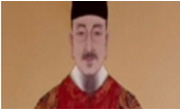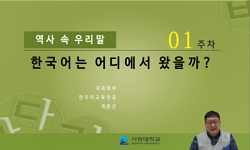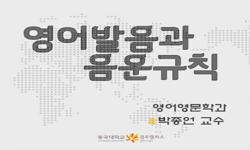The formant theory, which approximates and characterizes the sound spectrum by choosing two successive peak frequencies F1 and F2, is extended to the frequency lattice model by adding the vocal frequency F0 and by using the frequency and amplitude mod...
http://chineseinput.net/에서 pinyin(병음)방식으로 중국어를 변환할 수 있습니다.
변환된 중국어를 복사하여 사용하시면 됩니다.
- 中文 을 입력하시려면 zhongwen을 입력하시고 space를누르시면됩니다.
- 北京 을 입력하시려면 beijing을 입력하시고 space를 누르시면 됩니다.
https://www.riss.kr/link?id=A103562793
-
저자
박상업 (전주대학교)
- 발행기관
- 학술지명
- 권호사항
-
발행연도
2017
-
작성언어
Korean
-
주제어
Hun-Min-Jung-Eum ; Vowel ; Formant ; Frequency lattice ; 훈민정음 ; 모음도 ; 포만트 ; 진동 격자
-
등재정보
KCI등재,SCOPUS
-
자료형태
학술저널
- 발행기관 URL
-
수록면
211-220(10쪽)
-
KCI 피인용횟수
0
- 제공처
- 소장기관
-
0
상세조회 -
0
다운로드
부가정보
다국어 초록 (Multilingual Abstract)
The formant theory, which approximates and characterizes the sound spectrum by choosing two successive peak frequencies F1 and F2, is extended to the frequency lattice model by adding the vocal frequency F0 and by using the frequency and amplitude modulations to synthesize the fundamental frequencies ($\omega_1$, $\omega_2$). Thus, we define the frequency lattice and the formants F1 and as are points on the lattice. We see that the crystal structure will be useful in clarifying the human voice. We apply the lattice model to study the vowel structure of the Hun-Min-Jung-Eum, and see that the vowels are the first and the second neighboring lattice points centered at the vocal frequency $\omega_0$. We use the voices of Korea youth to discuss the lattice briefly.
국문 초록 (Abstract)
2개의 특성 진동수(F1과 F2)를 선택해서 음성 스펙트럼을 대표적으로 설명하는 포만트 이론을 성대 진동수 F0를 추가하여 진동수 격자 이론으로 확장한다. 포만트 F1과 F2가 성대 진동 F0에서 기...
2개의 특성 진동수(F1과 F2)를 선택해서 음성 스펙트럼을 대표적으로 설명하는 포만트 이론을 성대 진동수 F0를 추가하여 진동수 격자 이론으로 확장한다. 포만트 F1과 F2가 성대 진동 F0에서 기본 진동수 ($\omega_1$, $\omega_2$)에 따른 주파수 변조가 되게 진동수 격자 구조를 정의한다. 따라서 포만트 이론이 진동수 격자 이론의 제한된 형태임을 보인다. 고체의 결정 구조가 인간의 음성 분석에 중요한 역할을 할 것으로 보인다. 또한 진동수 격자 이론을 훈민정음을 살피는데 사용하고, 훈민정음 모음도가 중심 진동수 $\omega_0$에서 1차와 2차 인접 격자 진동수를 기호화한 것임을 보인다. 한국 청년의 소리를 중심으로 훈민정음 모음도에 따른 격자의 크기를 살핀다.
참고문헌 (Reference)
1 S. Kim, Yeongnam University 2015
2 M. Heo, 34 : 235-, 1992
3 M. LeBrun, 1 : 51-, 1977
4 L. Demany, 96 : 706-, 1994
5 J. Chowing, 21 : 526-, 1973
6 D. D. Greenwood, 33 : 1344-, 1961
7 A. Horner, 17 : 17-, 1993
8 E. Zwicker, 68 : 1523-, 1980
9 E. Zwicker, 33 : 248-, 1961
10 B. R. Glasberg, 47 : 103-, 1990
1 S. Kim, Yeongnam University 2015
2 M. Heo, 34 : 235-, 1992
3 M. LeBrun, 1 : 51-, 1977
4 L. Demany, 96 : 706-, 1994
5 J. Chowing, 21 : 526-, 1973
6 D. D. Greenwood, 33 : 1344-, 1961
7 A. Horner, 17 : 17-, 1993
8 E. Zwicker, 68 : 1523-, 1980
9 E. Zwicker, 33 : 248-, 1961
10 B. R. Glasberg, 47 : 103-, 1990
11 R. Plomp, 38 : 548-, 1965
12 J. Bate, 14 : 38-, 1990
13 박상업, "훈민정음의 원형 자음과 원형 모음의 과학적 원리" 한국물리학회 66 (66): 478-488, 2016
14 소강춘, "훈민정음의 안정적 음소 분할 원리의 과학적 탐색 -합리적 대화모형을 중심으로" 한국언어문학회 (94) : 31-67, 2015
15 박상업, "훈민정음 음소 분할의 소수성과 과학성" 한국물리학회 66 (66): 30-36, 2016
16 김슬옹, "한글 우수성, 독창성, 과학성에 대한 통합 연구" 한국문법교육학회 16 : 37-82, 2012
17 박재환, "기업가정신과 창업준비가 사업성과에 미치는 영향에 관한 연구: 창업인프라 활용 매개효과 중심으로" 한국벤처창업학회 11 (11): 39-47, 2016
18 A. C. Graham, "the Nature of Collective Thinking" Institute of East Asian Philosophies 1986
19 N. W. McLachlan, "Theory and Application of Mathieu Functions" Oxford 1947
20 J. Sundber, "The Science of the Singing Voice" Northern Illinois Univ. Press 1987
21 A. M. Kosevich, "The Crystal lattice" Wiley-VCH 2005
22 B. Martin, "Phonetics: The Science of Speech" Edward Arnold 1999
23 A. D. Partel, "Music, Language, and the Brain" Oxford 2008
24 G. B. Arfken, "Mathematical Methods for Physicists" Academic 2005
25 The Great King SeJong, "Hun-Min-Jung-Eum Hae-Rye"
26 J. Daniel, "English Pronouncing Dictionary" Cambridge University Press 2011
27 D. Abercrombie, "Elements of General Phonetics" Aldine 1967
28 E. T. Whittaker, "A Course of Mordern Analysis" Cambridge 1978
29 P. Ladefoged, "A Course in Phonetics" Wadsworth 2011
동일학술지(권/호) 다른 논문
-
- 한국물리학회
- 민태원
- 2017
- KCI등재,SCOPUS
-
Formulation of Statistical Mechanics in Terms of Information Theory
- 한국물리학회
- 김상락
- 2017
- KCI등재,SCOPUS
-
단일스칼라장과 결합된 아인슈타인 중력에서 BRST 전하
- 한국물리학회
- 고석태
- 2017
- KCI등재,SCOPUS
-
다중고리전선에 흐르는 전류의 자기작용 관련 실험수업에서 발생하는 문제들에 대한 이론적 분석 l module, Infographic type, Students’ perception
- 한국물리학회
- 현동걸
- 2017
- KCI등재,SCOPUS
분석정보
인용정보 인용지수 설명보기
학술지 이력
| 연월일 | 이력구분 | 이력상세 | 등재구분 |
|---|---|---|---|
| 2023 | 평가예정 | 해외DB학술지평가 신청대상 (해외등재 학술지 평가) | |
| 2020-01-01 | 평가 | 등재학술지 유지 (해외등재 학술지 평가) |  |
| 2016-09-05 | 학술지명변경 | 외국어명 : Sae Mulli(New Physics) -> New Physics: Sae Mulli |  |
| 2015-01-01 | 평가 | 등재학술지 유지 (등재유지) |  |
| 2011-01-01 | 평가 | 등재학술지 유지 (등재유지) |  |
| 2009-01-01 | 평가 | 등재학술지 유지 (등재유지) |  |
| 2007-01-01 | 평가 | 등재학술지 유지 (등재유지) |  |
| 2004-01-01 | 평가 | 등재학술지 선정 (등재후보2차) |  |
| 2003-01-01 | 평가 | 등재후보 1차 PASS (등재후보1차) |  |
| 2002-01-01 | 평가 | 등재후보학술지 유지 (등재후보1차) |  |
| 1999-07-01 | 평가 | 등재후보학술지 선정 (신규평가) |  |
학술지 인용정보
| 기준연도 | WOS-KCI 통합IF(2년) | KCIF(2년) | KCIF(3년) |
|---|---|---|---|
| 2016 | 0.18 | 0.18 | 0.17 |
| KCIF(4년) | KCIF(5년) | 중심성지수(3년) | 즉시성지수 |
| 0.15 | 0.14 | 0.3 | 0.1 |





 KCI
KCI







